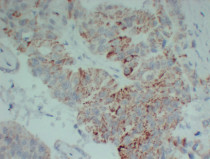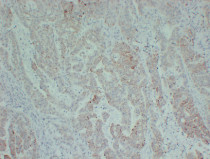ARG66433
anti-TGFBR2 / TGF beta Receptor II antibody
anti-TGFBR2 / TGF beta Receptor II antibody for IHC-Formalin-fixed paraffin-embedded sections and Human
Overview
| Product Description | Mouse Monoclonal antibody recognizes TGFBR2 / TGF beta Receptor II |
|---|---|
| Tested Reactivity | Hu |
| Tested Application | IHC-P |
| Host | Mouse |
| Clonality | Monoclonal |
| Isotype | IgG1, kappa |
| Target Name | TGFBR2 / TGF beta Receptor II |
| Antigen Species | Human |
| Immunogen | Synthetic peptide derived from Human TGFBR2 / TGF beta Receptor II. |
| Conjugation | Un-conjugated |
| Alternate Names | FAA3; AAT3; TbetaR-II; TGF-beta receptor type-2; LDS2B; MFS2; TGF-beta type II receptor; EC 2.7.11.30; TAAD2; TGFR-2; LDS2; Transforming growth factor-beta receptor type II; TGFbeta-RII; TGF-beta receptor type II; RIIC; LDS1B |
Application Instructions
| Application Suggestion |
|
||||
|---|---|---|---|---|---|
| Application Note | IHC-P: Antigen Retrieval: Heat mediation was performed. * The dilutions indicate recommended starting dilutions and the optimal dilutions or concentrations should be determined by the scientist. |
Properties
| Form | Liquid |
|---|---|
| Purification | Affinity purification with immunogen. |
| Buffer | PBS, 0.02% Sodium azide, 50% Glycerol and 0.5% BSA. |
| Preservative | 0.02% Sodium azide |
| Stabilizer | 50% Glycerol and 0.5% BSA |
| Concentration | 1 mg/ml |
| Storage Instruction | For continuous use, store undiluted antibody at 2-8°C for up to a week. For long-term storage, aliquot and store at -20°C. Storage in frost free freezers is not recommended. Avoid repeated freeze/thaw cycles. Suggest spin the vial prior to opening. The antibody solution should be gently mixed before use. |
| Note | For laboratory research only, not for drug, diagnostic or other use. |
Bioinformation
| Database Links | |
|---|---|
| Gene Symbol | TGFBR2 |
| Gene Full Name | transforming growth factor, beta receptor II (70/80kDa) |
| Background | This gene encodes a member of the Ser/Thr protein kinase family and the TGFB receptor subfamily. The encoded protein is a transmembrane protein that has a protein kinase domain, forms a heterodimeric complex with another receptor protein, and binds TGF-beta. This receptor/ligand complex phosphorylates proteins, which then enter the nucleus and regulate the transcription of a subset of genes related to cell proliferation. Mutations in this gene have been associated with Marfan Syndrome, Loeys-Deitz Aortic Aneurysm Syndrome, and the development of various types of tumors. Alternatively spliced transcript variants encoding different isoforms have been characterized. [provided by RefSeq, Jul 2008] |
| Function | Transmembrane serine/threonine kinase forming with the TGF-beta type I serine/threonine kinase receptor, TGFBR1, the non-promiscuous receptor for the TGF-beta cytokines TGFB1, TGFB2 and TGFB3. Transduces the TGFB1, TGFB2 and TGFB3 signal from the cell surface to the cytoplasm and is thus regulating a plethora of physiological and pathological processes including cell cycle arrest in epithelial and hematopoietic cells, control of mesenchymal cell proliferation and differentiation, wound healing, extracellular matrix production, immunosuppression and carcinogenesis. The formation of the receptor complex composed of 2 TGFBR1 and 2 TGFBR2 molecules symmetrically bound to the cytokine dimer results in the phosphorylation and the activation of TGFRB1 by the constitutively active TGFBR2. Activated TGFBR1 phosphorylates SMAD2 which dissociates from the receptor and interacts with SMAD4. The SMAD2-SMAD4 complex is subsequently translocated to the nucleus where it modulates the transcription of the TGF-beta-regulated genes. This constitutes the canonical SMAD-dependent TGF-beta signaling cascade. Also involved in non-canonical, SMAD-independent TGF-beta signaling pathways. [UniProt] |
| Cellular Localization | Cell membrane; Single-pass type I membrane protein. Membrane raft. [UniProt] |
| Calculated MW | 65 kDa |
| PTM | Phosphorylated on a Ser/Thr residue in the cytoplasmic domain. [UniProt] |
Images (2) Click the Picture to Zoom In
-
ARG66433 anti-TGFBR2 / TGF beta Receptor II antibody IHC-P image
Immunohistochemistry: Paraffin-embedded colon carcinoma stained with ARG66433 anti-TGFBR2 / TGF beta Receptor II antibody at 1:200, 4°C and overnight. Antigen Retrieval: Heat mediation was performed.
-
ARG66433 anti-TGFBR2 / TGF beta Receptor II antibody IHC-P image
Immunohistochemistry: Paraffin-embedded colon carcinoma stained with ARG66433 anti-TGFBR2 / TGF beta Receptor II antibody at 1:200, 4°C and overnight. Antigen Retrieval: Heat mediation was performed.







